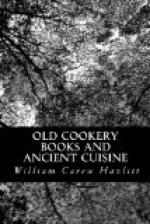The kitchen-staff of a noble establishment in the first quarter of the seventeenth century we glean from Braithwaite’s “Rules and Orders for the Government of the House of an Earl,” which, if the “M.L.” for whom the piece was composed was his future wife, Mistress Lawson, cannot have seen the light later than 1617, in which year they were married. He specifies—(1) a yeoman and groom for the cellar; (2) a yeoman and groom for the pantry; (3) a yeoman and groom for the buttery; (3a) a yeoman for the ewery; (4) a yeoman purveyor; (5) a master-cook, under-cooks, and three pastry-men; (6) a yeoman and groom in the scullery, one to be in the larder and slaughter-house; (7) an achator or buyer; (8) three conducts [query, errand-boys] and three kitchen-boys.
The writer also admits us to a rather fuller acquaintance with the mode in which the marketing was done. He says that the officers, among other matters, “must be able to judge, not only of the prices, but also of the goodness of all kinds of corn, cattle, and household provisions; and the better to enable themselves thereto, are oftentimes to ride to fairs and great markets, and there to have conference with graziers and purveyors.” The higher officers were to see that the master was not deceived by purveyors and buyers, and that other men’s cattle did not feed on my lord’s pastures; they were to take care that the clerk of the kitchen kept his day-book “in that perfect and good order, that at the end of every week or month it be pied out,” and that a true docket of all kinds of provisions be set down. They were to see that the powdered and salted meats in the larder were properly kept; and vigilant supervision was to be exercised over the cellar, buttery, and other departments, even to the prevention of paring the tallow lights.
Braithwaite dedicates a section to each officer; but I have only space to transcribe, by way of sample, the opening portion of his account of “The Officer of the Kitchen:” “The Master-Cook should be a man of years; well-experienced, whereby the younger cooks will be drawn the better to obey his directions. In ancient times noblemen contented themselves to be served with such as had been bred in their own houses, but of late times none could please some but Italians and Frenchmen, or at best brought up in the Court, or under London cooks: nor would the old manner of baking, boiling, and roasting please them, but the boiled meats must be after the French fashion, the dishes garnished about with sugar and preserved plums, the meat covered over with orangeade, preserved lemons, and with divers other preserved and conserved stuff fetched from the confectioner’s: more lemons and sugar spent in boiling fish to serve at one meal than might well serve the whole expense of the house in a day.” He goes on to describe and ridicule the new fashion of placing arms and crests on the dishes. It seems that all the refuse was the perquisite of the cook and his subordinates in a regulated proportion, and the same in the bakery and other branches; but, as may be supposed, in these matters gross abuses were committed.




